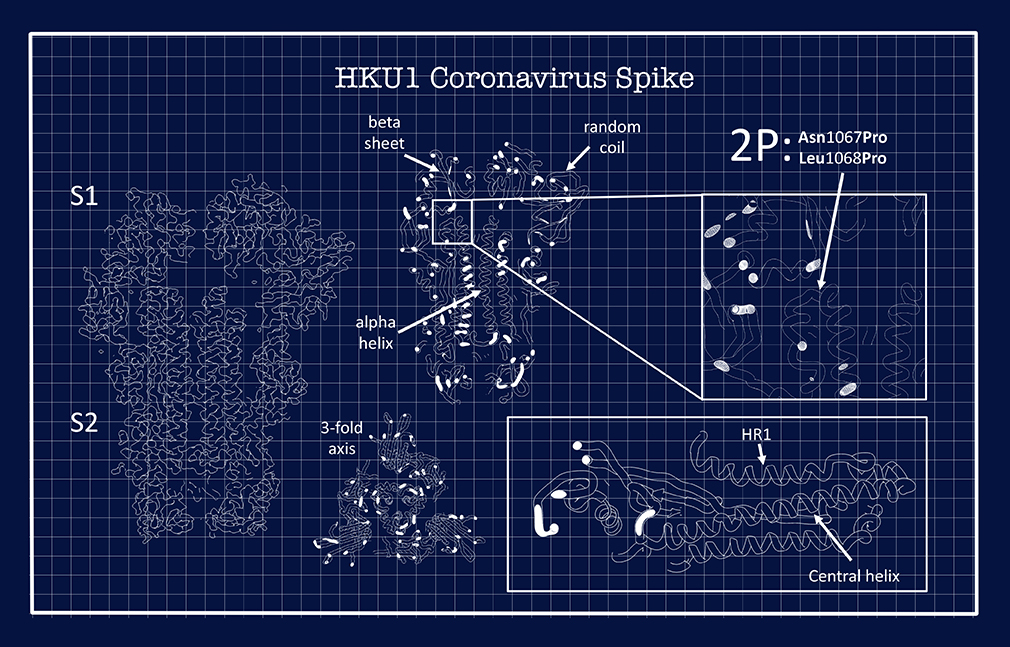
How Scripps Research helped map the course for today’s COVID-19 vaccines
Structural biologists developed the first detailed images of the coronavirus spike protein and then created a way to stabilize the protein for vaccines.
December 23, 2020
LA JOLLA, CA—Both of the coronavirus vaccines being distributed in the United States—and many of the experimental COVID-19 vaccines in development—are made possible with innovations born at Scripps Research, from the lab of Andrew Ward, PhD.
In a statement announcing the FDA’s emergency authorization of the Moderna vaccine, the National Institutes of Health and the Biomedical Advanced Research and Development Authority recognized Scripps Research among key collaborators who created elements of the vaccine technology.

“Vaccine development for COVID-19 is happening at an unprecedented pace today because of years of prior research across many disciplines,” says Ward, professor of Integrative Structural and Computational Biology, who began investigating coronaviruses more than five years ago.
In 2016, using some of the most advanced electron microscopy equipment in the world, Ward’s lab revealed the very first structure of a human coronavirus spike protein.
The discovery—in collaboration with the labs of Jason McLellan, PhD (University of Texas at Austin), and Barney Graham, MD, PhD (NIH Vaccine Research Center)—appeared in the journal Nature. The spike protein at the center of that study hailed from the HKU1 coronavirus, which causes seasonal colds. Ward’s lab then went on to solve the structures of the more dangerous coronaviruses SARS (severe acute respiratory syndrome) and MERS (Middle East respiratory syndrome).
“The reason we initially decided to work on coronaviruses was the expectation that they could cause a pandemic,” Ward says.
Coronaviruses use spike proteins to recognize and infect human cells. Understanding the protein’s shape and seeing how the spikes interact with protective antibodies is a critical step in designing a vaccine, Ward explains.
The 3-D “blueprints” of the spike enabled the engineering of mutations that stabilize the proteins so they keep their integrity when produced in large quantities with a vaccine. By exposing the immune system to this engineered spike via a vaccination, the body recognizes it as a foreign and makes neutralizing antibodies that can quickly fight back upon real-life exposure to the virus.

This stabilizing innovation is at use today in the two approved coronavirus vaccines—from Moderna and Pfizer/BioNTech—and in other vaccine candidates in development. (Watch: How vaccines work against COVID-19)
“It’s an illustration of how structural biology and basic research can directly contribute to creating vaccines,” Ward says.
Ward notes that the stabilizing mutations appear to work for other types of coronaviruses, such as SARS and MERS, and may be helpful in developing vaccines against future viruses. Looking forward, he’s optimistic that vaccines will be able to be produced more rapidly if a new pandemic emerges.
“The lessons learned now will definitely be used to combat future pandemics,” Ward says. “We’ll be able to take advantage of improvements in technology and computational tools to do this even faster in the future.”
Learn more: In a new Scripps Research video and podcast, Andrew Ward discusses his coronavirus work and the future of vaccines with Eric Topol, MD
For more information, contact press@scripps.edu

